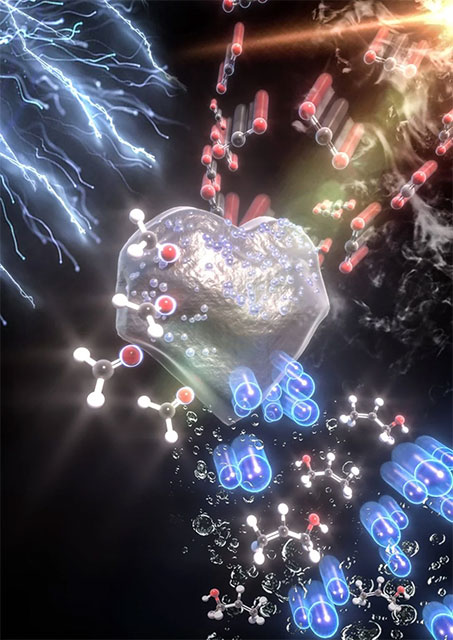South Korean scientists find way to turn CO₂ into 'liquid gold'
As climate change continues to escalate and carbon emissions reach record highs, the need to find efficient ways to recycle carbon dioxide (CO₂) has never been more urgent. With the global movement towards carbon neutrality gaining momentum, innovative methods of converting CO₂ into useful fuels and chemicals are rapidly gaining traction.
Among these, the conversion of CO₂ into alcohol-based products is particularly promising due to the high energy content and economic value of these compounds. Despite its great potential, this process has long been hampered by low efficiency and challenges in scaling up to industrial levels.
Recently, a team of scientists from the Gwangju Institute of Science and Technology (GIST) in Korea, led by Professor Dr. Jaeyoung Lee, Dr. Minjun Choi and Dr. Sooan Bae, announced an important breakthrough in this field.
The team's new approach to converting CO₂ to alcohol has set a global efficiency record by combining outstanding efficiency with the ability to produce at scale. Published in the journal Nature Catalysis, the new research reveals an electrochemical technique that converts CO₂ to 'allyl alcohol', a high-value compound with a range of industrial applications.

Challenges in reducing co₂ to high value compounds
Electrochemical CO₂ reduction is a key technology in the carbon neutral era, capable of converting CO₂ (the main culprit of global warming) into useful substances. However, the selective production of high value-added compounds with three or more carbon atoms, such as allyl alcohol, poses a number of challenges. Firstly, current methods only achieve very low Faraday efficiencies – less than 15% of the electrical energy used actually produces the desired compound, the rest is wasted. Secondly, the reaction pathway is complex and the intermediates have low stability, adding to the inefficiency of the process.
'Allyl alcohol (C₃H₆O) is a very useful substance that can be used in a variety of chemical reactions. However, the production of these high value-added compounds in liquid form is difficult due to the complicated carbon-carbon (C–C) bond formation process and the low stability of the reaction intermediate,' explained Professor Lee.
The technology developed by GIST researchers is remarkable. The team created a phosphorus-rich copper catalyst by integrating copper phosphide (CuP₂) into a membrane-electrode assembly along with a nickel-iron (NiFe) oxidation catalyst. Using this catalyst in an electrochemical system, they achieved a Faraday efficiency of up to 66.9%, which is about four times higher than the current state-of-the-art (<15%). This high efficiency demonstrates the catalyst's excellent selectivity, minimizing the production of unwanted byproducts and selectively producing only the required substance.
In addition, the technology also recorded a partial current density of 735.4 mA cm⁻² and a production rate of 1643 μmol cm⁻² h⁻¹ in a process that can apply a current of 1100 mA cm⁻² per unit electrode area. These figures represent the highest efficiencies reported to date and also highlight the potential for large-scale applications.
Industrial potential
Since allyl alcohol is used as an essential raw material in many industries such as plastics, adhesives, disinfectants and perfumes, the new technology could be a turning point for mass production of this compound.
Furthermore, the method is also unique in its mechanism of action. While conventional methods operate via the carbon monoxide (CO) pathway, this method reveals a novel reaction pathway in which a carbon–carbon (C–C) bond is formed during the conversion of an intermediate group from formate (HCOO⁻) to formaldehyde (HCHO). This mechanism significantly increases the commercial value of the product as it directly produces a liquid, which is easier to store and transport.
The new technology marks a breakthrough in the carbon neutral era and is expected to open new avenues for cost-effective electrochemical carbon capture and utilization, by selectively converting CO₂ (with only one carbon atom) into allyl alcohol, a high value-added multi-carbon compound (C3+) with three or more carbon atoms.
' This CO₂ conversion technology could open up new business avenues for the coal, petrochemical and steel industries that are facing increasing emissions pressures. We see it as an important stepping stone towards a carbon neutral era through scalable science and technology, ' Professor Lee stressed.
By shifting the focus beyond conventional C1 and C2 targets, the research expands the scope for CO₂ value capture towards more complex, higher-value molecules. Further integration into zero-gap membrane-electrode assembly and continuous-flow systems could enable sustainable, scalable production of liquid fuels and chemical precursors from CO₂ – significantly reducing dependence on fossil fuels and paving the way to a greener future.
You should read it
- The surprising relationship between climate change - birth rate and consequences
- Global warming is killing intestinal bacteria in lizards
- Is the alcohol meter accurate?
- Alcohol poisoning: symptoms and treatment
- Climate change is causing the sea to flow faster, scientists are still confused about what the harm will be
- Tips to help you get rid of alcohol quickly and effectively
 Windows 11 supports full desktop sharing with Copilot
Windows 11 supports full desktop sharing with Copilot This Gen4 NVMe SSD has a self-destruct mechanism when needed, but for good reason.
This Gen4 NVMe SSD has a self-destruct mechanism when needed, but for good reason. Windows 11 is about to have a completely new self-repair feature
Windows 11 is about to have a completely new self-repair feature Should I use an SD card as a memory expansion solution for my laptop?
Should I use an SD card as a memory expansion solution for my laptop? Google Chrome will stop supporting macOS 11 Big Sur
Google Chrome will stop supporting macOS 11 Big Sur Nokia 'dies'... again
Nokia 'dies'... again